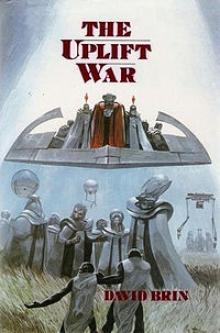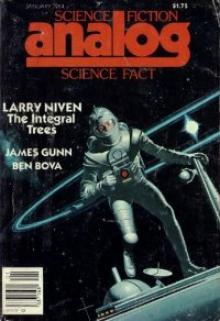- Home
- David Brin
Tank Farm Dynamo
Tank Farm Dynamo Read online
Tank Farm Dynamo
David Brin
Tank Farm Dynamo
by David Brin
1
“ They finally fired Bylinsky.”
I was up to my knees in agrisludge, a frothy brown mess at the bottom of my personal greenhouse tank, when I heard the remark. For a moment I thought I had imagined it.
Your hearing plays tricks when you’re wading around in mucky water, barely held to the floor by under a hundredth of a gee. I was groping in the goo, trying to find whatever had gummed up the aspirator. My breath blew up little green and brown droplets that hovered in front of my face for long seconds before slowly settling down again.
“Ralph! Did you hear me? I said Bylinsky’s out!”
I looked up this time. Don Ishido, our communications and operations chief, hung halfway through the aft hatch of the greenhouse, twenty meters away. He was watching my reaction, maybe in order to report to the others exactly how I took the news. Probably there was money riding on it.
I nodded. “Thanks, Don. Bylinsky’s days were numbered. We’ll miss him, but we’ll survive.”
Ishido smiled faintly. He must have bet on my poker face. “What do you want me to tell the others, boss?”
I shrugged. “We’re still a tank farm. We buy ’em and store ’em and later we’ll all get rich selling ’em back for a profit.”
“Even when they cut the water ration?”
“There’ll be a way. We’re in the future business. Now get out of here and let me finish my recreational farming.”
Don smirked at my euphemism, but withheld comment. He ducked out, leaving me alone to my “recreation”… and my worries.
After clearing a clump of gelatinized algae from the input ports, I climbed onto one of the catwalk longerons rimming the pond and turned on the bubbler. The air began to fill with tiny superoxygenated green droplets.
I took a leap and sailed across the huge chamber to alight near the exit hatch. There I stowed my waders and looked around the greenhouse to make sure it was ready.
In the ten years I’ve been living in tanks I doubt I’ve ever entered or left one without blinking at least once in awe. The hatch was at one end of a metal cylinder as long as a ten-story building is tall, with the diameter of a small house. The walls were stiffened with aluminum baffles which once kept a hundred tons of liquid hydrogen from sloshing under high stress. That ribwork now held my greenhouse ponds.
The former hydrogen tank had a volume of over fifty thousand cubic feet. It, and its brothers, were just about the largest things ever put into space. And this one was all mine—my own huge garden to putter around in during off-duty hours, growing new types of spaceadapted algae and yeasts.
I passed through the yard-wide hatch into the intertank area between the two main section of the External Tank. In the middle the intertank was only four feet across. The hatch closed.
Looking back into the garden tank through a tinted port, I pressed a button to let the sunshine in.
A bright point of light blossomed at the opposite end of the cylinder, mirror-focused sunlight speared through a fused quartz window to strike the cloud of rising bubbles.
I stayed long enough to watch the rainbows form.
The intertank hoop connects the big and little parts of the great External Tanks, or ETs, as we call them. The smaller cell had once contained 550 cubic meters of liquid oxygen. These days I stored gardening tools in it. Not a day had passed, in the last five years, in which I hadn’t wished someone on Earth would recognize the waste, and come and take my tool shed away from me—to be used in some grand and wonderful plan.
Now they were trying to do just that, but not in a way I cared for at all.
“Boss? You still there? There’s a telex from J.S.C. coming in.”
I grabbed the big steel beam that had once borne the thrust of giant, strap-on solid rocket boosters. Now it served as a convenient place to put the intercom.
“Ishido, this is Rutter. I’m on my way. Don’t let them sell us for scrap till I get there. Out.”
I put on my hardsuit, carefully double-checking each seal and valve. The lock cycled, and I emerged into vacuum, but not blackness.
Overhead the Earth spanned the sky, a broad velvet blanket of browns and blues and fleecy white clouds. From just five hundred kilometers up, you don’t see the Earth as a spinning marble in space. She covers an entire hemisphere, filling almost half the universe.
I drifted, but after a minute my boots touched the metal of the tank again. The same faint microgravity that held my pools inside the garden worked here on the outside.
The tank was the next to last in a row of forty of the great cylinders, nestled side by side. A parallel deck of sixteen huge tanks lay about sixty kilometers “overhead” linked to this collection by six strong cables. Twenty meters away from where I stood, one of the half-inch polymer tethers rose from its anchor point, a mirror-bright streak toward the planet overhead.
Sometimes a careful observer could make out B Deck without aid—a tiny rectangle about an eighth the apparent diameter of the moon—against the bright bulk of the Earth. When we crossed the terminator, the tanks in Group B sparkled like gems in Terra’s sunset tiara.
Today I hadn’t time to look for B Deck. The Feds had finally fired Edgar Bylinsky, the Tank Farm’s last big supporter in NASA. If we thought times were hard before, they were going to get worse now.
“Ralph?” It was Ishido’s voice again, now coming over my suit radio. “We’ve got the telex. I think this is the big one.”
I pushed off toward the control center. “Okay, what’s the news?”
“Uh, they’re moving fast. Pacifica’s coming in with a couple of official bad news boys.”
I could guess what they were coming to tell us. They’d say they were here for “consultations,” but actually it would be to say that Uncle Sam wasn’t going to sell us any more water.
“Don, when are the bad news boys due?”
“E.T.A. about an hour.”
“I’ll be right in.”
Another hop took me to the entrance of the control tank. It was sheathed in layers of plating cut from dismantled ETs, to protect the crew during solar proton storms.
While waiting for the airlock to cycle, I looked up at the Indian Ocean, where they used to dump our tanks back at the beginning of the shuttle program. That awful waste had been one of the reasons for founding the Tank Farm.
For years ours had been a lonely and expensive gamble. Now we had proved our point. Proved it too well, it seemed.
They let us get a monopoly, and now they want to break us, I thought. And they might succeed, if they cut off our water.
We had safeguarded the Key to Space for them, and expected them to be grateful when they realized its worth. We should have known better.
2
In the beginning there was the space shuttle. Never mind what came earlier. Before version two of the shuttle, space was a place for robots and daredevils.
With tight budgets and all, the Space Transportation System has stayed fundamentally the same. A big, complex manned orbiter is launched from Canaveral or Vandenberg, strapped to two solid rocket boosters and one huge fuel tank carrying 770 tons of cryogenic propellants for the shuttle main engines. The engines are part of the orbiter, so they can be brought home and reused. The solid boosters drop off minutes after liftoff and are recovered for refurbishment. Even the unmanned heavy-lift cargo launchers use the same basic system.
But until our group came along, the huge external tanks were simply dumped, after fueling the shuttle to almost orbital velocity.
Once upon a time people thought we were on the verge of colonizing space. But then tight budgets and disasters cut the size of
the STS fleet, and the cost of a pound sent into orbit remained in four figures. Visions of big O’Neill colonies and grand cities on the moon foundered without the bootstrap mass needed to build the dreams.
The lock passed me through. I stowed my hardsuit in a restorer locker whose nameplate simply read “Bossman.” While I racked my equipment, I recalled all the times I had explained the Tank Farm to audiences on Earth: to congressmen, housewives, investors—to anyone who would listen.
Back in the early eighties it was shown that the thirty-five-ton external tank can be carried all the way into orbit at zero cost to the orbiter’s thirty-ton cargo capacity. Thirty-five tons of aluminum and polymers, already shaped into vacuum-tight cylinders, delivered free!
And that wasn’t all. On arrival the tanks would contain another five to thirty-five tons of leftover liquid hydrogen and oxygen, usable in upper stage engines, or to run fuel cells, or to be converted to precious water.
At a time when the grand hopes for space seemed about to fall apart, the ET was like manna from Earth to Heaven. When the government didn’t seem eager to seize the opportunity—when they built their cramped, delicate, little “space stations” from expensive modules in the old-fashioned way—the Colombo-Carroll Foundation, a consortium of U.S. and Italian interests, offered to buy the tanks.
We would save them, until the world wised up, then sell them back. Meanwhile, the Tank Farm would provide orbit boosts via the tether-sling effect, saving customers fuel and time and paying our way until other investments matured.
For ten years the Farm had been on course, but it seems we’d omitted a few lines of fine print in our contract. The Feds had to let us buy the tanks at a fixed price, but nothing in the contract said they had to give us the residual hydrogen and oxygen, too.
It never occurred to us they’d not want to give us all the water we needed! Who in the world would have thought they’d ever want to take the Tank Farm away from us?
3
Imagine six very long parallel wires, hanging in space, always aimed toward the surface of the Earth 500 kilometers below.
At both ends the wires are anchored to flat rows of giant cylinders— forty in the upper layer, A Deck; and sixteen in the lower, B Deck. An elevator, consisting of two welded tanks, moves between the two ends, carrying people and supplies both ways.
I’ve lost count of the number of times I’ve explained the curious structure to visitors. I’ve compared it to a double-ended child’s swing, or a bolo turning exactly once always high. It’s been called a skyhook, and even a bean-stalk, though the idea’s nowhere near as ambitious as the ground-to-geosynchronous space-elevators of science fiction fame.
The main purpose of the design is simply to keep the tanks from falling. The two massive ends of the Farm act like a dipole in the gradient of the Earth’s gravitational field, so each deck winds up orbiting edge-forward, like a flat plate skimming. This reduces the drag caused by the upper fringes of the atmosphere, extending our orbital lifetime.
The scheme is simple, neat, and it works. Of course the arrangement doesn’t prevent all orbital decay. It takes a little thrust from our aluminum engines, from time to time, to make up the difference.
Since our center of mass is traveling in a circular orbit, the lower deck has to move much slower than it “should” to remain at its height. The tethers keep it suspended, as it were.
The upper deck, in turn, is dragged along faster than it would normally go, at its height. It would fly away into a high ellipse if the cables ever let go.
That’s why we feel a small artificial gravity at each end, directed away from the center of mass. It creates the ponds in my garden, and helps prevent the body decay of pure weightlessness.
When I entered the darkened control chamber, I moved quietly behind the chief flight controller and watched. The controller’s main screen showed the interdeck elevator stopped about three klicks above B Deck. The reason for its delay came into view in a few moments: a small delta-wing whose white tiles shone against the starfield. I stood in the shadows and listened as our operators conversed with the shuttle pilot.
“Pacifica, this is A for Arnold Deck control. You are cleared for orbit intersection. In a minute we’ll transfer you to B for Brown, for final approach. Extend your landing gear now.”
“Roger, Arnold Deck. Pacifica, ready for landing.”
The orbiter drifted toward B Deck. On the controller’s screen I could see Pacifica’s landing gear deploy in the deep black of space.
The inner face of B Deck was covered with a flat surface of aluminum plates, surrounded by a low fence of soft nylon mesh.
Pacifica was at the highest point of her elliptical orbit. Her velocity would, for a few minutes at apogee, be virtually the same as B Deck’s, allowing a gentle approach and contact. (A few purists still refused to call the docking a “landing.”) The shuttle gave off small puffs of reaction gas to align her approach.
It was a beautiful technique, and the unargued greatest asset of the Tank Farm. When Pacifica was secured to B Deck, she would be carried along in the Farm’s unconventional circular orbit until it was time for her to go. Then Pacifica would simply be pushed over the edge of B Deck, to fall toward the Earth again, finishing her original ellipse.
I looked at the screen showing the underbelly of B Deck. A great net of nylon hung below the plain of cylinders. Within, like a caterpillar trapped in a web, was Pacifica’s ET, the external tank that had powered her into orbit, sent ahead and snagged on a previous pass.
So the bad news boys had brought one of the magic eggs with them. I hoped it was a good omen, though it was probably just a coincidence of scheduling.
Until a year ago most of the orbiters visiting the Farm also delivered their external tanks, along with several tons of residual hydrogen and oxygen propellants in each. Then a new administration started reneging, stockpiling ETs at the Space Stations instead, and denying us our allotment. The Foundation took them to court, of course, and forced a delivery rate of at least ten ETs a year.
The new administration didn’t like losing face. Now they’d found a way to get even. Our contract said they had to sell us the tanks, but it said nothing about the water.
“Um, Dr. Rutter, could I speak with you for a minute?”
I turned to see an earnest-looking, black-haired young woman. She clutched a roll of strip charts. Emily Testa was a very promising new member of the Farm, sent up by the Italians, the junior partners in Colombo Station.
“This is really a bad time, Emily. Is it important?”
“Well, sir…” She caught my warning look. “I mean Ralph… Since I arrived I have been studying the problem of electrical currents in the tether cables, and I think I have learned something interesting.”
I nodded as I recalled the project I’d given the young newcomer to get her started. It was a nagging little problem that I’d wanted to have someone look into for some time.
The super-polymer tethers that held the Tank Farm together were sheathed in an aluminum skin to protect them from solar ultraviolet radiation. Unfortunately, this meant there was an electrical conducting path from B Deck to A Deck. As the Farm swept around the Earth in its unconventional orbit, the cables cut through a changing flux from the planet’s magnetic field. The resulting electrical potentials had caused some rather disconcerting side effects, especially as the Tank Farm grew larger.
“Go on, Emily,” I suggested. But I couldn’t help listening with only half my attention. Pacifica was coming in, gear extended like a fighter landing on an aircraft carrier. I could hear the controllers talking softly in their singsongy dialect.
“Well, sir,” Emily said, almost without a trace of accent, “I wasn’t able to find a way to prevent the potential buildup. I’m afraid the voltage is unavoidable as the conductive tethers pass through the Earth’s magnetic field.
“In fact, if the charge had anywhere to go, we could see some pretty awesome currents: One deck might act as a cathod
e, emitting electrons into the ionosphere, and the other could be an anode, absorbing electrons from the surrounding plasma. It all depends on whether…”
Pacifica touched down with barely a bump. Her landing gear flexed slightly as she rolled to a stop. The interdeck elevator resumed its descent as the orbiter was tied down by the B Deck crew. Her cargo was removed from the open cargo bay by giant manipulator arms.
Two spacesuited figures drifted down from Pacifica’s hatch and stood waiting for the elevator. It didn’t take a lot of imagination to guess who they were. Our bad news boys.
Emily went on single-mindedly, apparently unaware of my split attention. “…so we could, if we ever really wanted to, use this potential difference the tethers generate! We could shunt it through some transformers here on A Deck, and apply as much as twenty thousand volts! I calculate we might pull more power out of the Earth’s magnetic field, just by orbiting through it with these long wires, than we would ever need to run lights, heat, utilities, and communications, even if we grew to ten times our present size!”
The boys in the spacesuits got into the elevator. The crew loaded Pacifica’s cargo after them, encased in blue Department of Defense shrouding.
“Emily.” I turned to face the young woman. “You know there ain’t no such thing as a free lunch. Your idea certainly is interesting. I’ll grant you could probably draw current from the tethers, maybe even as much as you say. But we’d pay for it in ways we can’t afford.”
Emily stared for a moment, then she snapped her fingers. “Angular momentum! Of course! By drawing current we would couple with the Earth’s magnetic field. We would slow down, and add some of our momentum to the planet’s spin, microscopically. Our orbit would decay even faster than it already does!”
I nodded. “Right. Still, it’s a good idea. If we were getting all the water we used to receive, so we could run the aluminum engines as before, we might even decide to draw power your way.

 The Practice Effect
The Practice Effect Infinity's Shore
Infinity's Shore Insistence of Vision
Insistence of Vision Sundiver
Sundiver Brightness Reef
Brightness Reef Existence
Existence The Transparent Society
The Transparent Society Startide Rising
Startide Rising The Postman
The Postman The Uplift War
The Uplift War The Loom of Thessaly
The Loom of Thessaly Otherness
Otherness Sundiver u-1
Sundiver u-1 The Uplift War u-3
The Uplift War u-3 Infinity's Shore u-5
Infinity's Shore u-5 Brightness Reef u-4
Brightness Reef u-4 Uplift 2 - Startide Rising
Uplift 2 - Startide Rising Kiln People
Kiln People Heaven's Reach u-6
Heaven's Reach u-6 The Transparent Society: Will Technology Force Us to Choose Between Privacy and Freedom?
The Transparent Society: Will Technology Force Us to Choose Between Privacy and Freedom? Star Wars on Trial
Star Wars on Trial Lungfish
Lungfish Tank Farm Dynamo
Tank Farm Dynamo Just a Hint
Just a Hint A Stage of Memory
A Stage of Memory Foundation’s Triumph sf-3
Foundation’s Triumph sf-3 Thor Meets Captain America
Thor Meets Captain America Senses Three and Six
Senses Three and Six The River of Time
The River of Time Chasing Shadows: Visions of Our Coming Transparent World
Chasing Shadows: Visions of Our Coming Transparent World Foundation's Triumph
Foundation's Triumph Startide Rising u-2
Startide Rising u-2 The Fourth Vocation of George Gustaf
The Fourth Vocation of George Gustaf The Heart of the Comet
The Heart of the Comet The Crystal Spheres
The Crystal Spheres